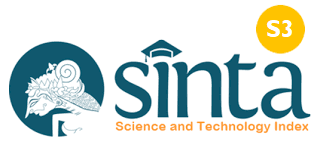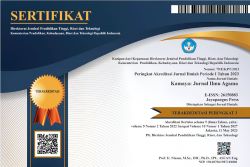Ajaran Agama Hindu Dalam Geguritan Candrabherawa Sebagai Penguatan Pendidikan Karakter
DOI:
https://doi.org/10.37329/kamaya.v3i2.434Keywords:
Education; Geguritan; Candrabherawa; CharacterAbstract
Literary works are not merely a bouquet made in a short period of time, but are made with the various components and elements that make a literary work so much appreciated. Bali also in its development also has so many heritages of traditional and modern literary works but which generally become a historical heritage containing so many sacred Hindu religious teachings and still so highly developed in Bali is a rash. The Geguritan as mentioned by experts is a traditional literary heritage in which there are elements of Hindu religion that becomes one of the media in conveying Hindu teachings. One of the most well-known rash is Candrabherawa, composed and composed by I Ketut Ruma which tells the story of the War of Hastinapura with Dewantara due to differences in the implementation of religious teachings. So, of course, there are profound philosophical teachings. The study of the rash of Candrabherawa texts emphasizes the study of the value of Hindu teachings contained in the rash text. From the results of the study, that the text of Candrabherawa is the teaching of Tri Hita Karana, Tri Kaya Parisudha, Catur Marga, and chess clan that can be a reference and guidance in implementing the internalization of Susila value on the strengthening of character education for students by education actors in education institutions.
References
Donder, I. K. (2006). Sisya Sista Pedoman Menjadi Siswa Mulia. Surabaya: Paramita.
Husamah. (2015). Pengantar Pendidikan. Malang: Umm Press.
Jalil, A. (2016). Karakter Pendidikan untuk Membentuk Pendidikan Karakter. Nadwa : Jurnal Pendiidkan Islam, 6(2), 175. https://doi.org/10.21580/nw.2012.6.2.586
Jayendra, P. S. (2017). AJARAN CATUR MARGA DALAM TINJAUAN KONSTRUKTIVISME DAN RELEVANSINYA DENGAN EMPAT PILAR PENDIDIKAN UNESCO. Sekolah Tinggi Pariwisata Bali (STPBI) Internasional Denpasar, (1), 73–84.
Madja, I. K. (2018). Landasan Pengembangan Etika Dan Moralitas Hindu. Guna Widya: Jurnal Pendidikan Hindu, 5(1), 67–78. https://doi.org/10.25078/gw.v5i1.613
Normina. (2017). Pendidikan dalam kebudayaan. Ittihad Jurnal Kopertais Wilayah XI Kalimantan, 15(28), 17–28.
Putu Sari, Ida Ayu & Rudita, K. G. (2019). DHARMAGITA SEBAGAI TERAPI SENI KEAGAMAAN HINDU UNTUK DOSEN DAN MAHASISWA PADA UNIT KEGIATAN MAHASISWA. Widyanatya, 1(2), 112–127. https://doi.org/10.1017/CBO9781107415324.004
Rai, A. A. I., Dewi, M., & Ganesha. (2014). PENGARUH MODEL VCT BERLANDASKAN KONSEP TRI KAYA SISWA KELAS V DI SD GUGUS III KECAMATAN SERIRIT 2013 / 2014. Jurnal Mimbar PGSD Universitas Pendidikan Ganesha, 02(01).
Rini, Y. S. (2010). pendidikan: Hakekat, Tujuan dan Proses. Jurnal Pendidikan, 1–13.
Setiawati, N. A. (2017). Pendidikan Karakter Sebagai Pilar Pembentukan Karakter Bangsa. Seminar Nasional Tahunan Fakultas Ilmu Sosial Universitas Negeri Medan, 1(1), 348–352.
Sudarsini, N. N., Vivekananda, A. And Sanstha, Y. (2018). Kasta Dan Warna: Sebuah Kritik Dalam Masyarakat Egaliter. Pangkaja : Jurnal Agama Hindu.
Sudarsini, N. N., Vivekananda, A., & Sanstha, Y. (2018). Kasta dan warna: sebuah kritik dalam masyarakat egaliter. Pangkaja : Jurnal Agama Hindu.
Sumantri, M. S. (2015). Modul Hakikat Manusia Dan Pendidikan.
Tribunnews.com. (2020). Motif siswi SMP berinisial NF (15) tega menghabisi nyawa teman rumahnya dengan keji akhirnya terungkap. Diambil dari https://www.tribunnews.com/metropolitan/2020/03/08/terungkap-motif-abg-bunuh-balita-dan-simpan-di-lemari-pelaku-semalaman-tidur-dekat-mayat-korban
UGM, F. (2020). Data UNICEF tahun 2016. Diambil dari UGM Website website: https://fk.ugm.ac.id/kekerasan-remaja-indonesia-mencapai-50-persen/
Utami, L. K. D. (2018). Kecerdasan Spiritual Sebagai Indikator Pen- Gukuran Keberhasilan Pelaksanaan Pendidi-. Guna Widya: Jurnal Pendidikan Hindu, 5(1), 17–32.
Downloads
Published
How to Cite
Issue
Section
License
An author who publishes in the Kamaya : Jurnal Ilmu Agama agrees to the following terms:
- Author retains the copyright and grants the journal the right of first publication of the work simultaneously licensed under the Creative Commons Attribution-ShareAlike 4.0 License that allows others to share the work with an acknowledgement of the work's authorship and initial publication in this journal
- Author is able to enter into separate, additional contractual arrangements for the non-exclusive distribution of the journal's published version of the work (e.g., post it to an institutional repository or publish it in a book) with the acknowledgement of its initial publication in this journal.
- Author is permitted and encouraged to post his/her work online (e.g., in institutional repositories or on their website) prior to and during the submission process, as it can lead to productive exchanges, as well as earlier and greater citation of the published work (See The Effect of Open Access).
Read more about the Creative Commons Attribution-ShareAlike 4.0 Licence here: https://creativecommons.org/licenses/by-sa/4.0/.





